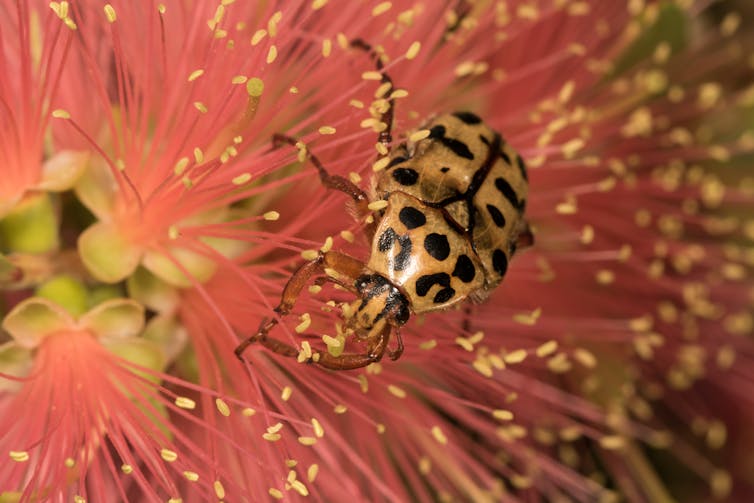
Beetles are the most diverse group of animals on Earth, accounting for nearly a quarter of all known animal species. Australia is thought to be home to a whooping 30,000 beetle species, and they are crucial to keeping our ecosystems healthy.
Beetles can be distinguished from other insects by their hard, shell-like wing covers called “elytra”. Unlike other insects, beetles hide their soft, thin wings beneath these protective covers when they are not in use.
Summer is a great time to go beetle-watching in Australia. While beetles can be found all year round, many species are more visible and numerous when the weather heats up.
Beetles come in a brilliant range of colours, patterns and textures – even metallic – which makes them especially fun to spot. Here are five beautiful beetles to look out for this summer.

1. Flower chafers
Although bees get all the glory, beetles are the unsung pollinators of many native plants.
Flower chafers (from the subfamily Cetoniinae) are named after their habit of visiting flowers to feed on nectar and pollen. This makes them important pollinators.
Flower chafer larvae live in rotting wood or leaf litter. There are 146 species in Australia, found in all states and territories..
One of the most common is the fiddler beetle (Eupoecila australasiae), found along Australia’s east coast. It features striking black, green and occasionally yellow markings in a fiddle-shaped pattern.
Female fiddler beetles lay eggs in soil or rotting logs. The larvae burrow through the soil to feed, emerging as adults in the spring.
The fiddler beetle feeds on native flowers such as Angophora, Melaleuca and Leptospermum (tea trees) and may occasionally eat rotting fruit.
Beetle-pollinated flowers are often white or cream, with nectar placed where beetles can readily reach it. The below video shows a native tree on which multiple species are feeding at once.
2. Stag beetles
The larvae of stag beetles (from the family Lucanidae) feed on decaying wood – breaking down tough, fibrous material and returning essential nutrients to the soil.
Adult stag beetles have been described as “beautiful baubles” for their shimmery exoskeletons in shades of gold, green, purple and blue.
Stag beetles are most abundant in Tasmania, New South Wales and Victoria, but are also found in Queensland, South Australia and Western Australia.
3. Christmas beetles
In southern and eastern Australia, the festive season is traditionally marked by the arrival of large numbers of iridescent Christmas beetles (Anoplognathus).
Of the 36 species of Christmas beetle, all but one are found exclusively in Australia, making them a truly iconic part of the country’s natural heritage.
Although Christmas beetles were once reliable heralds of summer, their numbers now appear to be declining. A lack of long-term population monitoring makes it challenging to confirm this trend, however.

4. Jewel beetles
Jewel beetles (from the family Buprestidae) feature brilliantly coloured, metallic bodies – features thought to deter predators.
Australia is lucky to have 1,200 species of these beautiful living jewels, found all across the continent.
Adult jewel beetles feed on nectar and pollen, while their larvae usually bore through the wood of trees or the roots of plants.
5. Diamond weevils
The diamond weevil (Chrysolopus spectabilis) is the crown jewel of Australia’s weevil family. It comes in a startling array of colours, from blue to yellow and green.
Diamond weevils are found commonly along the east coast of Australia, eating plant material such as Acacia leaves.
The species is one of Australia’s first insects named by European scientists. It was first collected in 1770 by naturalist Joseph Banks, who landed at Botany Bay with Captain Cook.

Saving our beetles
Despite their ecological importance and phenomenal diversity, beetles are understudied. Scientists are constantly finding new species, such as the adorable fluffy longhorn beetle (Excastra albopilosa) recently discovered in the Gold Coast hinterland.
Unfortunately beetles – like many other insect species – face increasing threats from habitat loss, climate change and the misuse of insecticide.
A few simple actions can help native beetles to thrive.
Planting nectar-rich natives helps provide a reliable food source for flower-feeding beetles. Choose native plants with large, bowl-shaped or flattened flowers which makes the nectar easy for insects to reach. Good examples include the dwarf apple (Angophora hispida), white kunzea (Kunzea ambigua) and rice flower (Ozothamnus diosmifolius).
As a bonus, flowers also attract pest-eating beetles such as ladybirds.
Many beetles rely on decaying leaves and wood for food and shelter. So try to avoid disturbing or removing rotting wood and leaf litter from natural habitats.
Avoid using insecticides in home gardens. Many insecticides commonly used to target pest beetles, such as the invasive Argentinian scarab, indiscriminately kill beneficial ground-dwelling beetle larvae.
And help scientists better understand beetle populations and their conservation needs by uploading beetle sightings to online platforms such as iNaturalist and Canberra Nature Mapr.
Public sightings can have a big impact. Participants in the annual Christmas Beetle Count have rediscovered seven species not seen for decades.
By protecting our valuable – and stunning – Australian beetles, we can ensure they survive for future generations to enjoy.
Tanya Latty receives funding from The Australian Research Council, Saving our Species and AgriFutures Australia. She is affiliated with Invertebrates Australia, The Australian Entomological Society and the Australasian Society for the Study of Animal Behaviour.
James Bickerstaff is affiliated with Invertebrates Australia and The Australian Entomological Society.
This article was originally published on The Conversation. Read the original article.







